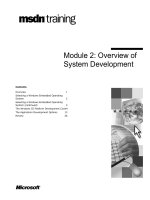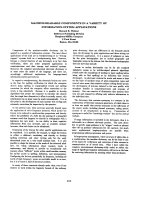Information system development p3 investigating
Bạn đang xem bản rút gọn của tài liệu. Xem và tải ngay bản đầy đủ của tài liệu tại đây (1.24 MB, 33 trang )
Matakuliah
Tahun
: M0054 Information System Development
: 2012
Topic 3
Investigating System Requirement
Rules
Read
active
Bina Nusantara
assignments
only
On time!
ask questions.
Requirements
On time!
Bina Nusantara
PERMISSION TO LEAVE
PROHIBITED BEHAVIOUR
Investigating System Requirement
Points to discuss :
•
•
•
•
The activity of analysis Phase
System Requirement
Techniques for Information Gathering
Activity Diagrams
Bina Nusantara
The Activities of the Analysis Phase
Figure 4-3
Systems Analysis and Design in a Changing World, 5th Edition
5
Activities of the Analysis Phase
and Their Key Questions
Figure 4-2
Systems Analysis and Design in a Changing World, 5th Edition
6
System Requirements
•
•
System requirements – specifications that define the new system
Functional requirements
–
–
–
Activities system must perform (use cases)
Based on procedures and business functions
Documented in analysis models
Systems Analysis and Design in a Changing World, 5th Edition
7
System Requirements (cont)
•
Nonfunctional requirements
–
–
–
–
–
Technical requirement – hardware and software
Performance requirement – workload measures
Usability requirement – user interface, workflow
Reliability requirement – outages, error detection
Security requirement – access & protection
Systems Analysis and Design in a Changing World, 5th Edition
8
Models and Modeling
•
•
•
•
•
Analyst describes information system requirements using a collection of models
Complex systems require more than one type of model
Models represent some aspect of the system being built
Process of creating models helps analyst clarify and refine design
Models assist communication with system users
Systems Analysis and Design in a Changing World, 5th Edition
9
Reasons for Modeling
Figure 4-3
Systems Analysis and Design in a Changing World, 5th Edition
10
Types of Models
•
Different types of models are used in information systems development
–
Mathematical – formulas that describe technical aspects of the system
–
Descriptive – narrative memos, reports, or lists that describe aspects of the system
–
Graphical – diagrams and schematic representations of some aspect of the system
Systems Analysis and Design in a Changing World, 5th Edition
11
Some Descriptive Models
Figure 4-4
Systems Analysis and Design in a Changing World, 5th Edition
12
Overview of Models Used
in Analysis and Design
•
Analysis activities named “define system requirements”
–
–
•
Logical models
Provide detail without regard to specific technology
Design models
–
–
–
Physical models
Provide technical details
Extend logical models
Systems Analysis and Design in a Changing World, 5th Edition
13
Models Created
During Analysis
Figure 4-5
Systems Analysis and Design in a Changing World, 5th Edition
14
Stakeholders—The Source of
System Requirements
•
People with interest in successful system implementation
•
Three primary groups of stakeholders
•
–
Users (use system)
–
Clients (pay for and own system)
–
Technical staff (ensure system operation)
Every type of stakeholder is identified by analyst
Systems Analysis and Design in a Changing World, 5th Edition
15
Stakeholders Interested
in New System Development
Figure 4-6
Systems Analysis and Design in a Changing World, 5th Edition
16
More On Users as Stakeholders
•
•
Horizontal user roles – information flow across departments
Vertical user roles – information needs of clerical staff, middle management, and senior
executives
–
–
–
–
–
Business users perform day-to-day operations
Information users need current information
Management users need summary information
Executive users need strategic information
External users may have access to system
Systems Analysis and Design in a Changing World, 5th Edition
17
RMO Stakeholders
Figure 4-7
Systems Analysis and Design in a Changing World, 5th Edition
18
Techniques for Information Gathering
•
Analysis phase done to understand business functions and develop system
requirements
•
Original structured approach
–
–
•
Create model of existing system
Derive requirements from existing system model
Current approach
–
–
Identify logical requirements for new system
Balance the review of current business functions with new system requirements
Systems Analysis and Design in a Changing World, 5th Edition
19
Relationship Between Information Gathering and Model Building
Figure 4-8
Systems Analysis and Design in a Changing World, 5th Edition
20
Themes for Information-Gathering Questions
Figure 4-9
Systems Analysis and Design in a Changing World, 5th Edition
21
Fact-Finding Methods
•
•
•
•
•
•
•
Review existing reports, forms, and procedure descriptions
Interview and discuss processes with users
Observe and document business processes
Build prototypes
Distribute and collect questionnaires
Conduct joint application design (JAD) sessions
Research vendor solutions
Systems Analysis and Design in a Changing World, 5th Edition
22
Review Existing Reports, Forms,
and Procedure Descriptions
•
•
Source: External industry-wide professional organizations and trade publications
Source: Existing business documents and procedure descriptions within organization
–
–
–
–
Identify business rules, discrepancies, and redundancies
Be cautious of outdated material
Obtain preliminary understanding of processes
Use as guidelines/visual cues to guide interviews
Systems Analysis and Design in a Changing World, 5th Edition
23
Sample Order Form for RMO
Figure 4-10
Systems Analysis and Design in a Changing World, 5th Edition
24
Conduct Interviews and Discussions with Users
•
•
•
Effective way to understand business functions and rules
Time consuming and resource expensive
May require multiple sessions to
–
–
•
•
Meet all users
Understand all processing requirements
Can meet with individuals or groups of users
List of detailed questions prepared
Systems Analysis and Design in a Changing World, 5th Edition
25









